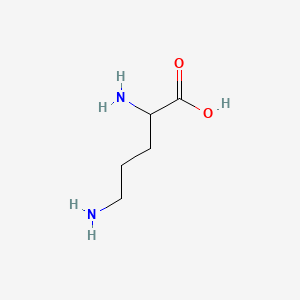| MeSH term | MeSH ID | Detail |
|---|---|---|
| Malaria, Vivax | D016780 | 2 associated lipids |
| Central Nervous System Bacterial Infections | D020806 | 1 associated lipids |
2,5-diaminopentanoic acid
2,5-diaminopentanoic acid is a lipid of Fatty Acyls (FA) class. The involved functions are known as Vasodilation, Intestinal Absorption and Pinocytosis. 2,5-diaminopentanoic acid often locates in Mitochondria, Microfilaments, NADH dehydrogenase complex and respiratory chain complex III location sensu Eukarya. The associated genes with 2,5-diaminopentanoic acid are GAPDH gene and iberiotoxin.
Cross Reference
Introduction
To understand associated biological information of 2,5-diaminopentanoic acid, we collected biological information of abnormalities, associated pathways, cellular/molecular locations, biological functions, related genes/proteins, lipids and common seen animal/experimental models with organized paragraphs from literatures.
What diseases are associated with 2,5-diaminopentanoic acid?
There are no associated biomedical information in the current reference collection.
Possible diseases from mapped MeSH terms on references
We collected disease MeSH terms mapped to the references associated with 2,5-diaminopentanoic acid
PubChem Associated disorders and diseases
What pathways are associated with 2,5-diaminopentanoic acid
There are no associated biomedical information in the current reference collection.
PubChem Biomolecular Interactions and Pathways
Link to PubChem Biomolecular Interactions and PathwaysWhat cellular locations are associated with 2,5-diaminopentanoic acid?
Visualization in cellular structure
Associated locations are in red color. Not associated locations are in black.
Related references are published most in these journals:
| Location | Cross reference | Weighted score | Related literatures |
|---|
What functions are associated with 2,5-diaminopentanoic acid?
Related references are published most in these journals:
| Function | Cross reference | Weighted score | Related literatures |
|---|
What lipids are associated with 2,5-diaminopentanoic acid?
There are no associated biomedical information in the current reference collection.
What genes are associated with 2,5-diaminopentanoic acid?
Related references are published most in these journals:
| Gene | Cross reference | Weighted score | Related literatures |
|---|
What common seen animal models are associated with 2,5-diaminopentanoic acid?
There are no associated biomedical information in the current reference collection.
NCBI Entrez Crosslinks
All references with 2,5-diaminopentanoic acid
Download all related citations| Authors | Title | Published | Journal | PubMed Link |
|---|---|---|---|---|
| Macedo JP et al. | Ornithine uptake and the modulation of drug sensitivity in Trypanosoma brucei. | 2017 | FASEB J. | pmid:28679527 |
| Aguilera S et al. | Temperature-mediated biosynthesis of the phytotoxin phaseolotoxin by Pseudomonas syringae pv. phaseolicola depends on the autoregulated expression of the phtABC genes. | 2017 | PLoS ONE | pmid:28570637 |
| Ye Q et al. | The value of grip test, lysophosphatidlycholines, glycerophosphocholine, ornithine, glucuronic acid decrement in assessment of nutritional and metabolic characteristics in hepatitis B cirrhosis. | 2017 | PLoS ONE | pmid:28384211 |
| Noens EE and Lolkema JS | Convergent evolution of the arginine deiminase pathway: the ArcD and ArcE arginine/ornithine exchangers. | 2017 | Microbiologyopen | pmid:27804281 |
| Biron BM et al. | Cl-Amidine Prevents Histone 3 Citrullination and Neutrophil Extracellular Trap Formation, and Improves Survival in a Murine Sepsis Model. | 2017 | J Innate Immun | pmid:27622642 |
| Papadaki G et al. | Neutrophil extracellular traps exacerbate Th1-mediated autoimmune responses in rheumatoid arthritis by promoting DC maturation. | 2016 | Eur. J. Immunol. | pmid:27585946 |
| Keogh D et al. | Enterococcal Metabolite Cues Facilitate Interspecies Niche Modulation and Polymicrobial Infection. | 2016 | Cell Host Microbe | pmid:27736645 |
| Braster Q et al. | Inhibition of NET Release Fails to Reduce Adipose Tissue Inflammation in Mice. | 2016 | PLoS ONE | pmid:27701440 |
| Rotroff DM et al. | Metabolomic signatures of drug response phenotypes for ketamine and esketamine in subjects with refractory major depressive disorder: new mechanistic insights for rapid acting antidepressants. | 2016 | Transl Psychiatry | pmid:27648916 |
| Hu L et al. | Identification of arginine and its "Downstream" molecules as potential markers of breast cancer. | 2016 | IUBMB Life | pmid:27641058 |
